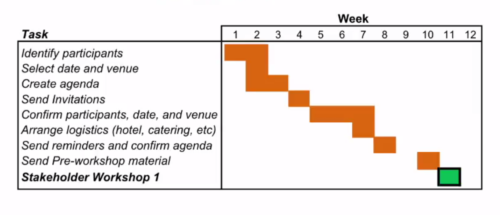Medulla of the Report Card Success: Project Management and Workshop Planning
Katya Altman ·In the previous lectures and blogs we talked about the five-step report card process: Step One - identifying basin values and threats, Step Two - choosing indicators, Step Three - defining thresholds for indicators, Step Four - calculating scores and determining grades, and Step Five - communicating results. How do we accomplish these steps and develop a report card in the end? This blog covers the latest lecture in the Healthy Rivers for All course, during which we discussed some essential elements of project planning and stakeholder workshops.
Project planning is more than just planning the project activities; it includes scoping, staffing, and developing a timeline. During the scoping stage of the project, identify objectives of the report card, temporal and geographic boundaries, and the audience that you are trying to reach. Staff the team with the expertise you need and assign roles and responsibilities to support the project. Plan for delays, the project will likely take longer to accomplish than you might think. On average, the report card development process takes about 18 months.

Try to complete Steps One and Two of the report card process at the first stakeholder workshop. The outcome of the first stakeholder workshop should include a shared understanding of values and threats of the river basin and preliminary indicators. You can also start to follow up with data providers and subject experts about indicator thresholds and create a sketch of what the report card is going to look like.
Share the draft report card, get feedback, and plan revisions at the second stakeholder workshop. You should continue to communicate with data providers and subject experts about the project, indicators, and thresholds. If necessary, adjust the process in accordance with your specific project goals and objectives.
The goal of these initial workshops is to meet with and connect stakeholders. A positive collaborative atmosphere helps to create high-level buy-in for the project and lays the path for the collaborative report card process. Therefore, the location and meeting space is important. The meeting place should be appropriate for the people attending in terms of the light, technology, and space for breakout sessions.

Creative ways of collaboration and engagement could incorporate design thinking techniques, "a human-centric creative process to build meaningful and effective solutions" (Gibbons, 2016). Design thinking promotes the creation of a shared understanding and also helps to identify each organization's responsibilities and develop an outline of potential roadblocks for the targeted results. Flexible and creative design thinking can also encourage flexibility and creativity in responses to the report card, not only from the government but also from the community.

Project planning and stakeholder engagement workshops are the foundation of the report card development process. The success of a report card mostly relies on skillful project management and productive collaborative workshops, which work towards the goals of the report card. Identifying a target audience and defining a clear understanding of what are you trying to accomplish will allow a report card to share the authentic story of a place with the local community and with the world.
Next Post > You Can’t Spell Earth Without Art
Comments
-
Kennedy 8 years ago
Good read Katya. Well done.
-
Ximena Celis 8 years ago
Thanks for your blog Katya, very usefull to understand the Project management and the workshop planning that is needed to make a succesful report card.
I have a question, how many workshops we need to make in order to get all the information we need for the report card? Is there a minumum, maximun? -
Irina 8 years ago
Very good blog Katia: clear and complete. I liked it very much!
-
Jodie Mehrtens 8 years ago
Great Blog Katya, and the link for design thinking is a great one!